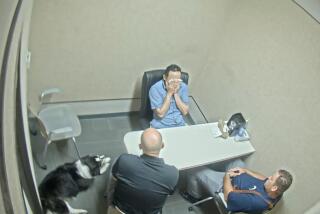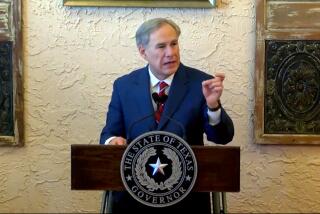CHP Officer’s Attacker Shot Self in Gunfire
- Share via
In what authorities say was a unique end to a violent case, Terry James Parker shot himself in the mouth shortly before pursuing police opened fire and killed him, an autopsy concluded Friday.
Parker fled after he had shot and critically wounded California Highway Patrol Officer Rafael Casillas, who was trying to stop Parker for speeding early Wednesday on the San Diego Freeway.
Casillas was in critical condition with stable vital signs at Providence Holy Cross Medical Center in Mission Hills, a spokeswoman said.
An operation Friday night “produced no surprises,” said surgeon Dantae Davies. The 2-hour, 15-minute operation was Casillas’ second.
Davies declined to make a long-term prognosis, saying that he was “cautiously optimistic” Casillas would pull through. “It’s a little better than we thought it would be at this point,” Davies said. “He’s very lucky to be alive.”
The autopsy showed that Parker died from both the self-inflicted wound and an undetermined number of other shots fired by three police officers who were closing in on him after he shot Casillas.
“There were powder burns on the roof of his mouth, suggesting he took his own life,” said coroner’s spokesman Scott Carrier. “The bullet penetrated the brain and exited through the skull, and he would have died. It would have been a fatal injury.”
Parker, an ex-convict and drug and alcohol abuser, had said he had wished he had died during a 1994 confrontation with police. “He said he wanted police to kill him,” Parker told his father, according to court records of the 1994 incident.
“How prophetic,” said LAPD Cmdr. Tim McBride. “This guy was really trying to commit suicide. His actions show that.”
Parker, who had been released from prison just a month ago, had a long and increasingly violent criminal past. He was known by police and neighbors as deeply troubled; some predicted his life would end in a police confrontation.
Parker’s father, James, said Friday he was aware of the autopsy results but he had no comment.
Los Angeles police were pursuing Parker after he led two CHP officers on a chase from the San Diego Freeway to his Harvest Street home in Granada Hills. It was a strikingly similar scenario as two years ago when Parker also led police on a pursuit to his home. In the earlier incident, police shot and wounded him.
This time, Parker ran inside his house and opened his front door shooting at Casillas and his partner, James Portilla. According to police, Parker fled, stopped to buy cigarettes at a local gas station, and hid near a tennis court on Rinaldi Street.
Acting on a tip from a clerk at the gas station, four Metropolitan Division officers with a police dog found Parker hiding in some bushes.
“They’re getting ready to approach the bush and a gunshot goes off,” McBride said. “They already know it’s him and they respond.”
Two of the officers involved in the gun battle told detectives that they saw the gun in Parker’s hand at about the same time they heard the gunshot, McBride said.
“All three felt they were being fired upon,” he said. “Almost simultaneously, they fired at him.”
The autopsy showed that Parker was shot by the officers “within seconds” after shooting himself. He had numerous bullet wounds and shotgun pellets in his upper torso, Carrier said. The death is being ruled a homicide because Parker was apparently still alive when he was shot by the police.
Pending a review of the shooting, McBride said he believes the officers did nothing wrong.
“It’ll be a justifiable homicide,” McBride said. “The officers were in fear of their life when they fired.”
CHP Officer Steve Tabor, who described himself as a close friend of Casillas, was at Holy Cross hospital waiting for word on Friday’s operation when he heard the report that Parker apparently shot himself.
“As long as he’s dead I don’t really care how he got that way,” Tabor said. “Right now I’m only thinking about Ralph getting better.”
Parker’s father has said earlier that his son was “paranoid” and believed that police had a conspiracy against him.
Parker had a lengthy criminal history, including drug and alcohol convictions. Three months after the April 1994 confrontation with police, Parker barricaded himself in his house, fired a weapon and refused to come out. Police finally lobbed tear gas into the home and Parker ultimately surrendered.
A probation report written after that incident stated that Parker was depressed by alcohol and drugs, which he had been using since he was a boy. The report concluded that Parker needed psychiatric treatment immediately because he was hearing voices and was suicidal.
While Parker served a 20-month prison term, which he completed June 20 for both 1994 incidents and a cocaine charge, he was given two mood-altering drugs prescribed by a prison psychiatrist. He did not participate in any drug or alcohol programs while in prison nor did he receive counseling, according to the Corrections Department.
After his release, Parker met with parole officials, but he was not referred for more counseling or treatment. Instead, officials were attempting to help Parker move to Arizona with his father.
Van Bell, a regional administrator for the Corrections Department, said he received the approval from Arizona authorities on Monday and that Parker was going to be contacted on Wednesday.
He died early Wednesday morning.
Further tests will be conducted to determine whether Parker had been drinking or using drugs prior to his gunfight with police. And, other analyses will be conducted to determine how many gunshots were fired at Parker.
Meanwhile, Casillas’ family and friends continued to hold a bedside vigil at the hospital.
Friday’s operation was needed to clean up the initial surgery to repair bullet damage to his liver, pancreas and gallbladder and to check for infection, surgeon Davies said. Though Casillas cannot talk because he’s on a ventilator, Davies said he is aware of what is happening to him and can communicate by using his hands.
“Everyone’s concerns and prayers are appreciated,” said Casillas’ sister, Theresa Gonzalez, with brother Javier Casillas and sister Margie Casillas at her side. “Keep Ralph in your prayers.”
In briefings Thursday and Friday, CHP supervisors reiterated the danger in traffic stops and reminded officers to use caution when pulling over motorists.
Said CHP officer Rob Lund: “This definitely increases your awareness.”
Correspondent Darrell Satzman contributed to this story.
More to Read
Sign up for Essential California
The most important California stories and recommendations in your inbox every morning.
You may occasionally receive promotional content from the Los Angeles Times.













